Robert Menzies
Sir Robert Gordon Menzies, KT, AK, CH, QC, FAA, FRS (/ˈmɛnziːz/; 20 December 1894 – 15 May 1978), was an Australian politician who twice served as Prime Minister of Australia, in office from 1939 to 1941 and again from 1949 to 1966. He played a central role in the creation of the Liberal Party of Australia, defining its policies and its broad outreach. He is Australia's longest-serving prime minister, serving over 18 years in total.
Sir Robert Menzies | |||||||||||||||||||||||||||||||||||||||||
|---|---|---|---|---|---|---|---|---|---|---|---|---|---|---|---|---|---|---|---|---|---|---|---|---|---|---|---|---|---|---|---|---|---|---|---|---|---|---|---|---|---|
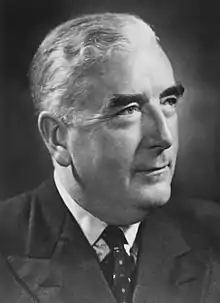 Menzies in the 1950s | |||||||||||||||||||||||||||||||||||||||||
| 12th Prime Minister of Australia | |||||||||||||||||||||||||||||||||||||||||
| In office 19 December 1949 – 26 January 1966 | |||||||||||||||||||||||||||||||||||||||||
| Monarch | George VI Elizabeth II | ||||||||||||||||||||||||||||||||||||||||
| Governor-General | Sir William McKell Sir William Slim Viscount Dunrossil Viscount De L'Isle Lord Casey | ||||||||||||||||||||||||||||||||||||||||
| Deputy | Arthur Fadden John McEwen | ||||||||||||||||||||||||||||||||||||||||
| Preceded by | Ben Chifley | ||||||||||||||||||||||||||||||||||||||||
| Succeeded by | Harold Holt | ||||||||||||||||||||||||||||||||||||||||
| In office 26 April 1939 – 29 August 1941 | |||||||||||||||||||||||||||||||||||||||||
| Monarch | George VI | ||||||||||||||||||||||||||||||||||||||||
| Governor-General | Lord Gowrie | ||||||||||||||||||||||||||||||||||||||||
| Deputy | Earle Page Archie Cameron Arthur Fadden | ||||||||||||||||||||||||||||||||||||||||
| Preceded by | Earle Page | ||||||||||||||||||||||||||||||||||||||||
| Succeeded by | Arthur Fadden | ||||||||||||||||||||||||||||||||||||||||
| Leader of the Opposition | |||||||||||||||||||||||||||||||||||||||||
| In office 23 September 1943 – 19 December 1949 | |||||||||||||||||||||||||||||||||||||||||
| Prime Minister | John Curtin Frank Forde Ben Chifley | ||||||||||||||||||||||||||||||||||||||||
| Deputy | Arthur Fadden | ||||||||||||||||||||||||||||||||||||||||
| Preceded by | Arthur Fadden | ||||||||||||||||||||||||||||||||||||||||
| Succeeded by | Ben Chifley | ||||||||||||||||||||||||||||||||||||||||
| |||||||||||||||||||||||||||||||||||||||||
| |||||||||||||||||||||||||||||||||||||||||
| |||||||||||||||||||||||||||||||||||||||||
| Personal details | |||||||||||||||||||||||||||||||||||||||||
| Born | Robert Gordon Menzies 20 December 1894 Jeparit, Colony of Victoria, British Empire | ||||||||||||||||||||||||||||||||||||||||
| Died | 15 May 1978 (aged 83) Malvern, Victoria, Australia | ||||||||||||||||||||||||||||||||||||||||
| Cause of death | Heart attack | ||||||||||||||||||||||||||||||||||||||||
| Resting place | Melbourne General Cemetery, Victoria, Australia | ||||||||||||||||||||||||||||||||||||||||
| Political party | Liberal (1945–1966) | ||||||||||||||||||||||||||||||||||||||||
| Other political affiliations | Nationalist (until 1931) United Australia (1931–1945) | ||||||||||||||||||||||||||||||||||||||||
| Spouse(s) | |||||||||||||||||||||||||||||||||||||||||
| Children | 4 | ||||||||||||||||||||||||||||||||||||||||
| Parents | James Menzies Kate Sampson | ||||||||||||||||||||||||||||||||||||||||
| Relatives | Sydney Sampson (uncle) Hugh Menzies (uncle) Douglas Menzies (cousin) Peter Henderson (son-in-law) | ||||||||||||||||||||||||||||||||||||||||
| Education | Wesley College | ||||||||||||||||||||||||||||||||||||||||
| Alma mater | University of Melbourne | ||||||||||||||||||||||||||||||||||||||||
| Profession | Lawyer politician | ||||||||||||||||||||||||||||||||||||||||
| Part of a series on |
| Liberalism in Australia |
|---|
|
Menzies studied law at the University of Melbourne and became one of Melbourne's leading lawyers. He was Deputy Premier of Victoria from 1932 to 1934, and then transferred to federal parliament, subsequently becoming Attorney-General and Minister for Industry in the government of Joseph Lyons. In April 1939, following Lyons's death, Menzies was elected leader of the United Australia Party (UAP) and sworn in as prime minister. He authorised Australia's entry into World War II in September 1939, and in 1941 spent four months in England to participate in meetings of Churchill's war cabinet. On his return to Australia in August 1941, Menzies found that he had lost the support of his party and consequently resigned as prime minister. He subsequently helped to create the new Liberal Party, and was elected its inaugural leader in August 1945.
At the 1949 federal election, Menzies led the Liberal–Country coalition to victory and returned as prime minister. His appeal to the home and family, promoted via reassuring radio talks, matched the national mood as the economy grew and middle-class values prevailed; the Labor Party's support had also been eroded by Cold War scares. After 1955, his government also received support from the Democratic Labour Party, a breakaway group from the Labor Party. Menzies won seven consecutive elections during his second term, eventually retiring as prime minister in January 1966. Despite the failures of his first administration, his government is remembered for its development of Canberra, its expanded post-war immigration scheme, its emphasis on higher education, and its national security policies, which saw Australia contribute troops to the Korean War, the Malayan Emergency, the Indonesia–Malaysia confrontation, and the Vietnam War.
Early life
Birth and family background
Robert Gordon Menzies was born on 20 December 1894 at his parents' home in Jeparit, Victoria.[1] He was the fourth of five children born to Kate (née Sampson) and James Menzies; he had two elder brothers, an elder sister, and a younger brother. Menzies was the first Australian prime minister to have two Australian-born parents: his father was born in Ballarat and his mother in Creswick. His grandparents on both sides had been drawn to Australia by the Victorian gold rush. His maternal grandparents were born in Penzance, Cornwall.[2] His paternal grandfather, also named Robert Menzies, was born in Renfrewshire, Scotland, and arrived in Melbourne in 1854.[3] The following year he married Elizabeth Band, the daughter of a cobbler from Fife.[4] Menzies was proud of his Scottish heritage, and preferred his surname to be pronounced in the traditional Scottish manner (/ˈmɪŋɪs/ MING-iss) rather than as it is spelled (/ˈmɛnziz/ MEN-zeez). This gave rise to his nickname "Ming", which was later expanded to "Ming the Merciless" after the comic strip character.[5] His middle name was given in honour of Charles George Gordon.[6]
The Menzies family had moved to Jeparit, a small Wimmera township, in the year before Robert's birth.[2] At the 1891 census, the settlement had a population of just 55 people.[7] His elder siblings had been born in Ballarat, where his father was a locomotive painter at the Phoenix Foundry. Seeking a new start, he moved the family to Jeparit to take over the general store,[2] which "survived rather than prospered".[7] During Menzies's childhood, three of his close relatives were elected to parliament. His uncle Hugh was elected to the Victorian Legislative Assembly in 1902, followed by his father in 1911, while another uncle, Sydney Sampson, was elected to the federal House of Representatives in 1906.[8] Each of the three represented rural constituencies, and were defeated after a few terms. Menzies's maternal grandfather John Sampson was active in the trade union movement. He was the inaugural president of the Creswick Miners' Association, which he co-founded with future Labor MP William Spence, and was later prominent in the Amalgamated Miners' Association.[2]
Childhood
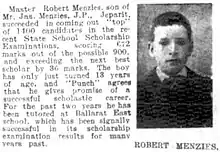
Growing up, Menzies and his siblings "had the normal enjoyments and camaraderies of a small country town".[9] He began his formal education in 1899 at the Jeparit State School, a single-teacher one-room school.[6] When he was about eleven, he and his sister were sent to Ballarat to live with his paternal grandmother; his two older brothers were already living there. In 1906, Menzies began attending the Humffray Street State School in Bakery Hill. The following year, aged 13, he ranked first in the state-wide scholarship examinations. This feat financed the entirety of his secondary education, which had to be undertaken at private schools, as Victoria did not yet have a system of public secondary schools.[10] In 1908 and 1909, Menzies attended Grenville College, a small private school in Ballarat Central.[11] He and his family moved to Melbourne in 1910, where he enrolled in Wesley College.[12] Menzies was "not very interested in and certainly incompetent at sport", but excelled academically. In his third and final year at Wesley he won a £40 exhibition for university study, one of 25 awarded by the state government.[13]
University
In 1913, Menzies entered the Melbourne Law School. He won a variety of prizes, exhibitions, and scholarships during his time as a student, graduating as a Bachelor of Laws (LL.B.) in 1916 and a Master of Laws (LL.M.) in 1918. He did, however, fail Latin in his first year.[14] One of his prize-winning essays, The Rule of Law During the War, was published as a brochure with an introduction by Harrison Moore, the law school dean. In 1916, Menzies was elected president of the Student Representatives' Council and editor of the Melbourne University Magazine. He wrote both prose and poetry for the magazine,[15] and also contributed a song about "little Billy Hughes" to an end-of-year revue.[16] Menzies was also president of the Students' Christian Union, a founding member of the Historical Society, and a prominent member of the Law Students' Society. He had "a reputation as an "unusually bright and articulate member of the undergraduate community", and was known as a skilful debater.[15] However, he had also begun to develop the traits of pomposity and arrogance that would cause difficulties later in his career. His fellow law student and future parliamentary colleague Percy Joske noted Menzies as a student "did not suffer fools gladly [...] the trouble was that his opponents frequently were not fools and that he tended to say things that were not only cutting and unkind but that were unjustified".[17]
During World War I, Menzies served his compulsory militia service in the Melbourne University Rifles (a part-time militia unit)[18] from 1915 to 1919.[19] This unit was not efficient and Menzies noted in his diary that training in even basic skills such as rifle shooting was sub-standard.[19] He was commissioned a second lieutenant on 6 January 1915.[20] Unlike many of his contemporaries, he did not volunteer for overseas service, something that would later be used against him by political opponents; in 1939 he described it as "a stream of mud through which I have waded at every campaign in which I have participated". Menzies never publicly addressed the reasons for his decision not to enlist, stating only that they were "compelling" and related to his "intimate personal and family affairs".[21] His two older brothers did serve overseas. In a 1972 interview, his brother Frank Gladstone (crown solicitor for Victoria during the 1929 Hogan government)[22]:69 recalled that a "family conference" had determined that Robert should not enlist. They believed that having two of the family's three adult sons serving overseas was a sufficiently patriotic contribution to the war effort, and that the family's interests would be served best by Robert continuing his academic career.[23] Another reason for keeping one of the elder sons home was the health of their father, James, who was physically unwell and emotionally unstable at the time.[24] It has been noted that, as a student, Menzies supported the introduction of compulsory overseas conscription, which if implemented would have made him one of the first to be conscripted.[19] Promoted to lieutenant, he resigned his commission with effect from 16 February 1921.[25]
Legal career
After graduating from the University of Melbourne in 1916 with first-class honours in Law, Menzies was admitted to the Victorian Bar and to the High Court of Australia in 1918. Establishing his own practice in Melbourne, Menzies specialised chiefly in constitutional law which he had read with the leading Victorian jurist and future High Court judge, Sir Owen Dixon.[8] In 1920, Menzies served as an advocate for the Amalgamated Society of Engineers which eventually took its appeal to the High Court of Australia.[8] The case became a landmark authority for the positive reinterpretation of Commonwealth powers over those of the States. The High Court's verdict raised Menzies's profile as a skilled advocate, and eventually he was appointed a King's Counsel in 1929.
Career in Victorian state politics, 1928–1934

In 1928, Menzies entered state parliament as a member of the Victorian Legislative Council from East Yarra Province, representing the Nationalist Party of Australia. He stood for constitutional democracy, the rule of law, the sanctity of contracts and the jealous preservation of existing institutions. Suspicious of the Labor Party, Menzies stressed the superiority of free enterprise except for certain public utilities such as the railways.[26] His candidacy was nearly defeated when a group of ex-servicemen attacked him in the press for not having enlisted, but he survived this crisis. Within weeks of his entry to parliament, he was made a minister without portfolio in a new minority Nationalist State government led by Premier William McPherson. The new government had formed when the previous Labor government lost the support of the cross-bench Country Progressives.[27] The following year he shifted to the Legislative Assembly as the member for Nunawading. In 1929, he founded the Young Nationalists as his party's youth wing and served as its first president. Holding the portfolios of Attorney-General and Minister for the Railways, Menzies served as Deputy Premier of Victoria from May 1932 until July 1934.
Early career in federal politics, 1934–1939
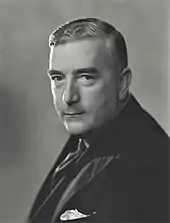
In August 1934, Menzies resigned from state parliament to contest the federal seat of Kooyong in the upcoming general election for the United Australia Party (UAP—the Nationalists had merged with other non-Labor groups to form the UAP during his tenure as a state parliamentarian). The previous member, John Latham, had given up the seat in order to prepare for appointment as Chief Justice of Australia. Kooyong was a safely conservative seat based on Kew, and Menzies won easily. He was immediately appointed Attorney-General and Minister for Industry in the Lyons government. In 1937 he was appointed a Privy Counsellor. In late 1934 and early 1935 Menzies, then attorney-general, unsuccessfully prosecuted the government's highly controversial case for the attempted exclusion from Australia of Egon Kisch, a Czech Jewish communist.[28] The initial prohibition on Kisch's entry to Australia, however, had not been imposed by Menzies but by the Country Party minister for the interior, Thomas Paterson.[8]
Menzies had extended discussions with British experts on Germany in 1935, but could not make up his mind whether Adolf Hitler was a "real German patriot" or a "mad swash-buckler". He expressed both views with an inclination to the former, says historian David Bird. In published essays in 1936, he called for a "live and let-live" attitude.[29] He condemned Nazi antisemitism, in 1933 writing to the organisers of an anti-Nazi protest at the Melbourne Town Hall that "I hope that I may be associated with the protest of the meeting tonight against the barbaric and medieval persecution to which their fellow Jews in Europe are apparently being subjected".[30] In 1939, Menzies described that "history will label Hitler as one of the great men of the century".[31]
In August 1938, while Attorney-General of Australia, Menzies spent several weeks on an official visit to Nazi Germany. He was strongly committed to democracy for the British peoples, but he initially thought that the Germans should take care of their own affairs. He strongly supported the appeasement policies of the Chamberlain government in London, and sincerely believed that war could and should be avoided at all costs.[32][33] after the visit to Germany in 1938, Menzies wrote that the "abandonment by the Germans of individual liberty ... has something rather magnificent about it".[34] Menzies also praised the "really spiritual quality in the willingness of Germans to devote themselves to the service and well-being of the state".[35]
Menzies supported British foreign policy, including appeasement, and was initially reticent about the prospect of going to war with Germany. However, by September 1939 the unfolding crisis in Europe changed his public stance that the diplomatic efforts by Chamberlain and other leaders to broker a peace agreement had failed, and that war was now an inevitability. In his Declaration of War broadcast on 3 September 1939, Menzies explained the dramatic turn of events over the past twelve months necessitating this change of course:
In those past 12 months, what has happened? in cold-blooded breach of the solemn obligations implied in both the statements I have quoted, Hitler has annexed the whole of the Czechoslovak state. Has, without flickering an eyelid, made a pact with Russia, a country the denouncing and reviling of which has been his chief stock-in-trade ever since he became chancellor. And has now, under circumstances which I will describe to you, invaded with armed force and in defiance of civilised opinion, the independent nation of Poland. Your own comments on this dreadful history will need no reinforcement by me. All I need say is, that whatever the inflamed ambitions of the German Führer may be, he will undoubtedly learn, as other great enemies of freedom have learned before, that no empire, no dominion, can be soundly established upon a basis of broken promises or dishonoured agreements.[36]
Menzies went on to say that if Hitler's expansionist "policy were allowed to go unchecked there could be no security in Europe and there could be no just peace for the world".[37] However, in a letter written by Menzies on 11 September 1939, he privately urged for peace negotiations and the continuation of appeasement with Hitler.[38]
Meanwhile, on the domestic front, animosity developed between Sir Earle Page and Menzies which was aggravated when Page became Acting Prime Minister during Lyons's illness after October 1938. Menzies and Page attacked each other publicly. He later became deputy leader of the UAP. His supporters began promoting him as Lyons's natural successor; his critics accused Menzies of wanting to push Lyons out, a charge he denied.
In 1938, as part of the Dalfram dispute, he was ridiculed as Pig Iron Bob, the result of an industrial conflict with the Waterside Workers' Federation whose members had refused to load Australian pig iron being sold to an arms manufacturer in the Empire of Japan, for that country's war against China.[39] In 1939, he resigned from the Cabinet in protest at postponement of the national insurance scheme and insufficient expenditure on defence.
First period as prime minister, 1939–1941
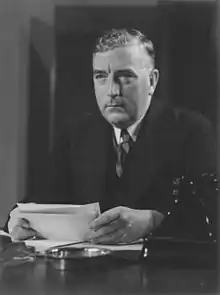
With Lyons's sudden death on 7 April 1939, Page became caretaker prime minister until the UAP could elect a new leader. On 18 April 1939, Menzies was elected party leader over three other candidates. He was sworn in as prime minister eight days later.
A crisis arose almost immediately, however, when Page refused to serve under him. In an extraordinary personal attack in the House, Page accused Menzies of cowardice for not having enlisted in the War, and of treachery to Lyons. Menzies then formed a minority government. When Page was deposed as Country Party leader a few months later, Menzies took the Country Party back into his government in a full-fledged Coalition, with Page's successor, Archie Cameron, as number-two-man in the government. On 3 September 1939 Britain and France declared war on Germany due to its invasion of Poland on 1 September, leading to the start of World War II.[17] Menzies responded immediately by also declaring Australia to be at war in support of Britain, and delivered a radio broadcast to the nation on that same day, which began "Fellow Australians. It is my melancholy duty to inform you officially that in consequence of a persistence by Germany in her invasion of Poland, Great Britain has declared war upon her and that, as a result, Australia is also at war."[18][19] A couple of days after the declaration, Menzies recalled parliament and asked for general support as the government faced the enormous responsibility of leading the nation in war time. Page and Curtin, as party leaders, pledged their support for all that needed to be done for the defence of the country.[40]
Thus, Menzies at the age of 44 found himself a wartime leader of a small nation of 7 million people. He was especially worried about the military threat from Japan. Australia had very small forces, and depended on Britain for defence against the looming threat of the Japanese Empire, with its 100 million people, a very powerful Army and Navy and an aggressive foreign policy. He hoped that a policy of appeasement would head off a war with Japan, and repeatedly pressured London.[41] Menzies did his best to rally the country, but the bitter memories of the disillusionment which followed World War I made his task difficult; this was compounded by his lack of a service record. Furthermore, as attorney-general and deputy prime minister, he had made an official visit to Germany in 1938, when the official policy of the Australian government, supported by the Opposition, was strong support for Neville Chamberlain's policy of Appeasement. Menzies, then also holding the responsibility for the Department of Munitions created a couple of months earlier, led the Coalition into the 1940 election and suffered an eight-seat swing, losing the slender majority he had inherited from Lyons. The result was a hung parliament, with the Coalition two seats short of a majority. Menzies managed to form a minority government with the support of two independent MPs, Arthur Coles and Alex Wilson. Labor, led by John Curtin, refused Menzies's offer to form a war coalition, and opposed using the Australian army for a European war, preferring to keep it at home to defend Australia. Labor agreed to participate in the Advisory War Council. Menzies sent the bulk of the army to help the British in the Middle East and Singapore, and told Winston Churchill the Royal Navy needed to strengthen its Far Eastern forces.[42]
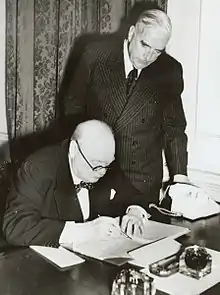
From 24 January 1941, Menzies spent four months in Britain discussing war strategy with Churchill and other Empire leaders, while his position at home deteriorated. En route to the UK he took the opportunity to stop over to visit Australian troops serving in the North African Campaign. Professor David Day, an Australian historian, has posited that Menzies might have replaced Churchill as British prime minister, and that he had some support in the UK for this. Support came from Viscount Astor, Lord Beaverbrook and former WWI Prime Minister David Lloyd George,[43] who were trenchant critics of Churchill's purportedly autocratic style, and favoured replacing him with Menzies, who had some public support for staying on in the War Cabinet for the duration, which was strongly backed by Sir Maurice Hankey, former WWI Colonel and member of both the WWI and WWII War Cabinets. Writer Gerard Henderson has rejected this theory, but history professors Judith Brett and Joan Beaumont support Day, as does Menzies's daughter, Heather Henderson, who claimed Lady Astor "even offered all her sapphires if he would stay on in England".[43]
Menzies came home to a hero's welcome. However, his support in Parliament was less certain. Not only did some Coalition MPs doubt his popularity in the electorate, but they also believed that a national unity government was the only long-term solution. Matters came to a head in August, when the cabinet voted to have Menzies return to London to speak for Australia's interests in the War Cabinet. However, since Labor and the Coalition were level (both sides had 36 MPs), Menzies needed the support of the Labor Party in order to travel to Britain.[44] Amid rumours that Menzies's real intention was to launch a political career in Britain, Labor insisted that the crisis was too dire for Menzies to leave the country.[45]
With Labor unwilling to support him travelling to London and his position within his own party room weakening, Menzies called an emergency cabinet meeting. He announced his intention to resign and advise the Governor-General, Lord Gowrie to commission Curtin as Prime Minister. The Cabinet instead urged Menzies to make another overture to Labor for a national unity government, but Labor turned the offer down. With his position now untenable, Menzies resigned the prime ministership on 27 August 1941.[44]
A joint UAP-Country Party conference chose Country Party leader Arthur Fadden as Coalition leader—and hence Prime Minister—even though the Country Party was the junior partner in the Coalition.[46] Menzies was bitter about this treatment from his colleagues, and nearly left politics,[47] but was persuaded to become Minister for Defence Co-ordination in Fadden's cabinet.[48] The Fadden Government lasted only 40 days before being defeated on a confidence motion. On 9 October 1941, Menzies resigned as leader of the UAP after failing to convince his colleagues that he should become Leader of the Opposition in preference to Fadden. He was replaced as UAP leader by former prime minister Billy Hughes, who was 79 years old at the time.[49]
Formation of Liberal Party and Return to Power
| ||
|---|---|---|
Prime Minister of Australia
Ministries Elections |
||
Menzies's Forgotten People
During his time in the political wilderness Menzies built up a large popular base of support by his frequent appeals, often by radio, to ordinary non-elite working citizens whom he called 'the Forgotten People'—especially those who were not suburban and rich or members of organised labour. From November 1941, he began a series of weekly radio broadcasts reaching audiences across New South Wales, Victoria and Queensland. A selection of these talks was edited into a book bearing the title of his most famous address, The Forgotten People, delivered on 22 May 1942. In this landmark address, Menzies appealed to his support base:
I do not believe that the real life of this nation is to be found either in great luxury hotels and the petty gossip of so-called fashionable suburbs, or in the officialdom of the organised masses. It is to be found in the homes of people who are nameless and unadvertised, and who, whatever their individual religious conviction or dogma, see in their children their greatest contribution to the immortality of their race. The home is the foundation of sanity and sobriety; it is the indispensable condition of continuity; its health determines the health of society as a whole.[50]
Menzies himself described The Forgotten People collection as 'a summarised political philosophy'. Representing the blueprint of his liberal philosophy, The Forgotten People encompassed a wide range of topics including Roosevelt's Four Freedoms, the control of the war, the role of women in war and peace, the future of capitalism, the nature of democracy and especially the role of the middle class, 'the forgotten people' of the title and their importance to Australia's future as a democracy.[51] The addresses frequently emphasised the values which Menzies regarded as critical to shaping Australia's wartime and postwar policies. These were essentially the principles of liberalism: individual freedom, personal and community responsibility, the rule of law, parliamentary government, economic prosperity and progress based on private enterprise and reward for effort.[51]
After losing the UAP leadership, Menzies moved to the backbench. Besides his overall sense of duty, the war would have made it nearly impossible for him to return to his legal practice in any event.[44] Labor won a crushing victory at the 1943 election, taking 49 of 74 seats and 58.2 percent of the two-party-preferred vote as well as a Senate majority. The Coalition, which had sunk into near-paralysis in opposition, was knocked down to only 19 seats. Hughes resigned as UAP leader, and Menzies was elected as his successor on the second ballot, defeating three other candidates. The UAP also voted to end the joint opposition arrangement with the Country Party, allowing Menzies to replace Fadden as opposition leader.
Formation of the Liberal Party of Australia
Soon after his return, Menzies concluded that the UAP was at the end of its useful life. Menzies called a conference of anti-Labor parties with meetings in Canberra on 13 October 1944 and again in Albury (NSW) in December 1944. At the Canberra conference, the fourteen parties, with the UAP as the nucleus, decided to merge as one new non-Labor party—the Liberal Party of Australia. The organisational structure and constitutional framework of the new party was formulated at the Albury Conference. Officially launched at the Sydney Town Hall on 31 August 1945, the Menzies-led Liberal Party of Australia inherited the UAP's role as senior partner in the Coalition. Curtin died in office in 1945 and was succeeded by Ben Chifley.
The reconfigured Coalition faced its first national test in the 1946 election. It won 26 of 74 seats on 45.9 percent of the two-party vote, and remained in minority in the Senate. Despite winning a seven-seat swing, the Coalition failed to make a serious dent in Labor's large majority.
1949 election campaign
Over the next few years, however, the anti-communist atmosphere of the early Cold War began to erode Labor's support. In 1947, Chifley announced that he intended to nationalise Australia's private banks, arousing intense middle-class opposition which Menzies successfully exploited. In addition to campaigning against Chifley's bank nationalization proposal, Menzies successfully led the 'No' case for a referendum by the Chifley government in 1948 to extend commonwealth wartime powers to control rents and prices.[8] In the election campaign of 1949, Menzies and his party were resolved to stamp out the communist movement and to fight in the interests of free enterprise against what they termed as Labor's 'socialistic measures'. If Menzies won office, he pledged to counter inflation, extend child endowment and end petrol rationing.[8] With the lower house enlarged from 74 to 121 seats, the Menzies Liberal/Country Coalition won the 1949 election with 74 House seats and 51.0 percent of the two-party vote but remained in minority in the Senate. Whatever else Menzies's victory represented, his anti-communism and advocacy for free enterprise had captured a new and formidable support base in postwar Australian society.[8]
Second period as prime minister, 1949–1966
After his election victory, Menzies returned to the office of Prime Minister on 19 December 1949.
Cold War and national security
The spectre of communism and the threat it was deemed to pose to national security became the dominant preoccupation of the new government in its first phase. Menzies introduced legislation in 1950 to ban the Communist Party, hoping that the Senate would reject it and give him a trigger for a double dissolution election, but Labor let the bill pass. It was subsequently ruled unconstitutional by the High Court. But when the Senate rejected his banking bill, he called a double dissolution election. At that election, the Coalition suffered a five-seat swing, winning 69 of 121 seats and 50.7 percent of the two-party vote. However, it won six seats in the Senate, giving it control of both chambers. Later in 1951 Menzies decided to hold a referendum on the question of changing the Constitution to permit the parliament to make laws in respect of Communists and Communism where he said this was necessary for the security of the Commonwealth. If passed, this would have given a government the power to introduce a bill proposing to ban the Communist Party. Chifley died a few months after the 1951 election. The new Labor leader, Dr H. V. Evatt, campaigned against the referendum on civil liberties grounds, and it was narrowly defeated. Menzies sent Australian troops to the Korean War. Economic conditions deteriorated in the early 1950s and Labor was confident of winning the 1954 election. Shortly before the election, Menzies announced that a Soviet diplomat in Australia Vladimir Petrov, had defected, and that there was evidence of a Soviet spy ring in Australia, including members of Evatt's staff. Evatt felt compelled to state on the floor of Parliament that he'd personally written to Soviet Foreign Minister Vyacheslav Molotov, who assured him there were no Soviet spy rings in Australia, bringing the House into silence momentarily before both sides of Parliament laughed at Evatt's naivety.[52]
This Cold War scare was claimed by some to enable the Menzies government to win the election. The Menzies government won 64 of 121 seats and 49.3 percent of the two-party vote. Evatt accused Menzies of arranging Petrov's defection. The aftermath of the 1954 election caused a split in the Labor Party, with several anti-Communist members from Victoria defecting to form the Australian Labor Party (Anti-Communist). The new party directed its preferences to the Liberals, with the Menzies government re-elected with an increased majority at the 1955 election. Menzies was re-elected almost as easily at the 1958 election, again with the help of preferences from what had become the Democratic Labor Party. By this time the post-war economic recovery was in full swing, fuelled by massive immigration and the growth in housing and manufacturing that this produced. Prices for Australia's agricultural exports were also high, ensuring rising incomes.
Foreign policy
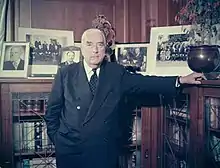
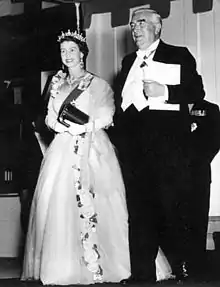
The Menzies era saw immense regional changes, with post-war reconstruction and the withdrawal of European Powers and the British Empire from the Far East (including independence for India and Indonesia). In response to these geopolitical developments, the Menzies government maintained strong ties with Australia's traditional allies such as Britain and the United States while also reorienting Australia's foreign policy focus towards the Asia Pacific. With his first Minister for External Affairs, Percy Spender, the Menzies government signed the ANZUS treaty in San Francisco on 1 September 1951. Menzies later told parliament that this security pact between Australia, New Zealand and the United States was 'based on the utmost good will, the utmost good faith and unqualified friendship' saying 'each of us will stand by it'.[53] At the same time as strengthening the alliance with the United States, Menzies and Spender were committed to Australia being on 'good neighbour terms' with the countries of South and South East Asia. To help forge closer ties in the region, the Menzies government initiated the Colombo Plan that would see almost 40 000 students from the region come to study in Australia over the four subsequent decades.[54] Recognising the economic potential of a burgeoning postwar Japan, Menzies, together with Trade Minister Jack McEwan and his new minister for External Affairs, Richard Casey, negotiated the Commerce Agreement with Japan in 1957. This trade agreement was followed by bilateral agreements with Malaya in 1958 and Indonesia in 1959.[53] With the Menzies government expanding Australia's diplomatic footprint in the region during its second term, a further six new high commissions and embassies were established in South East Asia from 1949 to 1966. Complementing Australia's growing diplomatic engagement in Asia, the Menzies government delivered a comprehensive aid programme to the region which comprised 0.65 per cent of Australia's Gross National Income by 1966.
While engaging Australia more closely with its neighbours in the Asia Pacific, the Menzies government maintained a strong interest in British and European affairs, especially the unfolding Suez Crisis of 1956. With the Egyptian leader Colonel Nasser's nationalization of the Suez Canal Company on 26 July 1956, Britain and France reacted angrily to Egypt's restriction on the free use of this waterway for international trade and commerce. Sympathetic to British interests, Menzies led a delegation to Egypt to try to force Nasser to compromise with the West. Although, at the time it was seen as confirming Menzies's status as a world statesman, it was of vital importance to Australia's shipping trade with Britain. Menzies publicly supported the Anglo-French invasion of Egypt during the Suez Crisis.
Elsewhere, Menzies publicly professed continued admiration for links with Britain, exemplified by his admiration for Queen Elizabeth II (whose 1953 Coronation he attended), and famously described himself as "British to the bootstraps". At a function attended by the Queen at Parliament House, Canberra, in 1963, Menzies quoted the Elizabethan poet Thomas Ford, "I did but see her passing by, and yet I love her till I die".
Defence policy
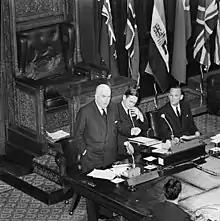
Confronting the challenges of the Cold War, the Menzies government shifted Australia to a policy of 'forward defence' as the most effective means of dealing with the threat of communism abroad. Australia's defence policy was conducted in close cooperation with the United States under the aegis of the ANZUS treaty. The Menzies government responded to successive communist insurgencies by committing Australian troops to the Korean War of 1950–51, the Malayan Emergency from 1948 to 1960, the Borneo Confrontation of 1963 and to the escalating conflict in Vietnam in 1965. To strengthen defence ties with countries in the Asia Pacific region, the Menzies government signed the South East Asia Collective Defence Treaty (SEATO) as a South East Asian counterpart to NATO. On the domestic front, the Menzies government introduced a scheme of national service where 'call ups' were issued to 18-year-old men to undertake a period of compulsory military training. Established in 1951, the scheme ended in 1960 but was reintroduced in 1964 in the form of the National Service Lottery.
Economic policy
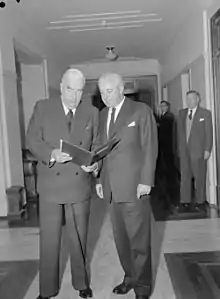
Throughout his second period in office, Menzies practised classical liberal economics with an emphasis on private enterprise and self-sufficiency in contrast to Labor's 'socialist objective'. Accordingly, the economic policy emphasis of the Menzies Government moved towards tax incentives to release productive capacity, boosting export markets, research and undertaking public works to provide power, water and communications.[55] As Prime Minister, Menzies presided over a period of sustained economic growth which led to nation-building and development, full employment, unprecedented opportunities for individuals and rising living standards.
The Menzies Government pursued what became known as "McEwenism" – a policy of high tariff protection for the manufacturing industry, so that industry would not challenge the continuing high tariffs on imported raw materials, which benefitted farmers but pushed up industry's costs. This policy was a part (some argue the foundation) of what became known as the "Australian settlement" which promoted high wages, industrial development, government intervention in industry (Australian governments traditionally owned banks and insurance companies and the railways and through policies designed to assist particular industries) and decentralisation.
In 1951, the top marginal tax rate for incomes above £10,000 what is equivalent to $425,000 today, was 75 per cent under Menzies. from 1955 until the mid-1980s the top marginal tax rate was 67 per cent.[56]
Social reform
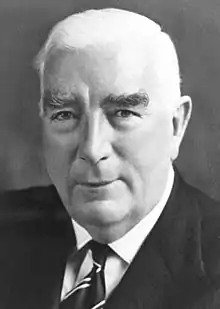
In 1949, Parliament legislated to ensure that all Aboriginal ex-servicemen should have the right to vote. In 1961 a Parliamentary Committee was established to investigate and report to the Parliament on Aboriginal voting rights and in 1962, Menzies's Commonwealth Electoral Act provided that all Indigenous Australians should have the right to enrol and vote at federal elections.[57]
In 1960, the Menzies Government introduced a new pharmaceutical benefits scheme, which expanded the range of prescribed medicines subsidised by the government. Other social welfare measures of the government included the extension of the Commonwealth Child Endowment scheme, the pensioner medical and free medicines service, the Aged Persons' Homes Assistance scheme, free provision of life-saving drugs; the provision of supplementary pensions to dependent pensioners paying rent; increased rates of pension, unemployment and sickness benefits, and rehabilitation allowances; and a substantial system of tax incentives and rewards.[58] In 1961, the Matrimonial Causes Act introduced a uniform divorce law across Australia, provided funding for marriage counselling services and made allowances for a specified period of separation as sufficient grounds for a divorce.[59]
In response to the decision by the Catholic Diocese of Goulburn in July 1962 to close its schools in protest at the lack of government assistance, the Menzies Government announced a new package of state aid for independent and Catholic schools. Menzies promised five million pounds annually for the provision of buildings and equipment facilities for science teaching in secondary schools. Also promised were 10 000 scholarships to help students stay at school for the last two years with a further 2 500 scholarships for technical schools.[60] Despite the historically firm Catholic support base of the Labor Party, the Opposition under Calwell opposed state aid before eventually supporting it with the ascension of Gough Whitlam as Labor leader.
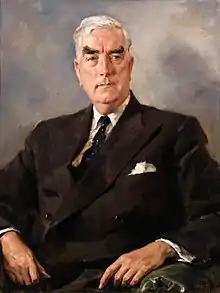
In 1965, the Menzies Government took the decision to end open discrimination against married women in the public service, by allowing them to become permanent public servants, and allowing female officers who were already permanent public servants to retain that status after marriage.[61]
Immigration policy
The Menzies government maintained and indeed expanded the Chifley Labor government's postwar immigration scheme established by Immigration Minister, Arthur Calwell in 1947. Beginning in 1949, Immigration Minister Harold Holt decided to allow 800 non-European war refugees to remain in Australia, and Japanese war brides to be admitted to Australia.[62] In 1950 External Affairs Minister Percy Spender instigated the Colombo Plan, under which students from Asian countries were admitted to study at Australian universities, then in 1957 non-Europeans with 15 years' residence in Australia were allowed to become citizens. In a watershed legal reform, a 1958 revision of the Migration Act introduced a simpler system for entry and abolished the "dictation test" which had permitted the exclusion of migrants on the basis of their ability to take down a dictation offered in any European language. Immigration Minister, Sir Alexander Downer, announced that 'distinguished and highly qualified Asians' might immigrate. Restrictions continued to be relaxed through the 1960s in the lead up to the Holt Government's watershed Migration Act, 1966.[63]
This was despite when in a discussion with radio 2UE's Stewart Lamb in 1955 he was a defender of the White Australia policy.
(Menzies) "I don't want to see reproduced in Australia the kind of problem they have in South Africa or in America or increasingly in Great Britain. I think it's been a very good policy and it's been of great value to us and most of the criticism of it that I've ever heard doesn't come from these oriental countries it comes from wandering Australians.
(Lamb) "For these years of course in the past Sir Robert you have been described as a racist."
(Menzies) "Have I?"
(Lamb) "I have read this, yes."
(Menzies) "Well if I were not described as a racist I'd be the only public man who hasn't been."[64][65]
Higher education expansion
The Menzies government extended Federal involvement in higher education and introduced the Commonwealth scholarship scheme in 1951, to cover fees and pay a generous means-tested allowance for promising students from lower socioeconomic groups.[66] In 1956, a committee headed by Sir Keith Murray was established to inquire into the financial plight of Australia's universities, and Menzies's pumped funds into the sector under conditions which preserved the autonomy of universities.[8] In its support for higher education, the Menzies government tripled Federal government funding and provided emergency grants, significant increases in academic salaries, extra funding for buildings, and the establishment of a permanent committee, from 1961, to oversee and make recommendations concerning higher education.[67]
Development of Canberra as a national capital
The Menzies government developed the city of Canberra as the national capital. In 1957, the Menzies government established the National Capital Development Commission as independent statutory authority charged with overseeing the planning and development of Canberra.[68] During Menzies time in office, the great bulk of the federal public service moved from the state capitals to Canberra.[68]
After politics
Menzies turned 71 in December 1965 and began telling others of his intention to retire in the new year. He informed cabinet of his decision on 19 January 1966 and resigned as leader of the Liberal Party the following day; Harold Holt was elected unopposed as his successor. Holt's swearing-in was delayed by the death of Defence Minister Shane Paltridge on 21 January. Menzies and Holt were pall-bearers at Paltridge's state funeral in Perth on 25 January, before returning to Canberra where Menzies formally concluded his term on 26 January.[69]
Menzies' farewell press conference was the first political press conference telecast live in Australia.[70] He resigned from Parliament on 17 February, ending 32 years in Parliament (most of them spent as either a cabinet minister or opposition frontbencher), a combined 25 years as leader of the non-Labor Coalition, and 38 years as an elected official. To date, Menzies is the last Australian prime minister to leave office on his or her own terms. He was succeeded as Liberal Party leader and prime minister by his former treasurer, Harold Holt. He left office at the age of 71 years, 1 month and 6 days, making him the oldest person ever to be prime minister. Although the coalition remained in power for almost another seven years (until the 1972 Federal election), it did so under four different prime ministers, largely due to his successor's death, only 22 months after taking office.
On his retirement he became the thirteenth chancellor of the University of Melbourne and remained the head of the university from March 1967 until March 1972. Much earlier, in 1942, he had received the first honorary degree of Doctor of Laws of Melbourne University. His responsibility for the revival and growth of university life in Australia was widely acknowledged by the award of honorary degrees in the Universities of Queensland, Adelaide, Tasmania, New South Wales, and the Australian National University and by thirteen universities in Canada, the United States and Britain, including Oxford and Cambridge. Many learned institutions, including the Royal College of Surgeons (Hon. FRCS) and the Royal Australasian College of Physicians (Hon. FRACP), elected him to Honorary Fellowships, and the Australian Academy of Science, for which he supported its establishment in 1954, made him a fellow (FAAS) in 1958.[71] On 7 October 1965, Menzies was installed as the ceremonial office of Lord Warden of the Cinque Ports and Constable of Dover Castle as appointed by the Queen, which included an official residence at Walmer Castle during his annual visits to Britain. At the end of 1966 Menzies took up a scholar-in-residence position at the University of Virginia. He presented a series of lectures, published the following year as Central Power in the Australian Commonwealth. He later published two volumes of memoirs. In March 1967 he was elected Chancellor of Melbourne University, serving a five-year term.[72][73] In 1971, Menzies suffered a severe stroke and was permanently paralysed on one side of his body for the remainder of his life. He suffered a second stroke in 1972. His official biographer, Lady McNicoll wrote after his death in The Australian that Menzies was "splendid and sharp right up until the end" also that "each morning he underwent physiotherapy and being helped to face the day." In March 1977, Menzies accepted his knighthood of the Order of Australia (AK) from Queen Elizabeth in a wheelchair in the Long Room of the Melbourne Cricket Ground during the Centenary Test.[74]
Personal life
On 27 September 1920, Menzies married Pattie Leckie at Kew Presbyterian Church in Melbourne. Pattie Leckie was the eldest daughter of John Leckie, a Deakinite Commonwealth Liberal who was elected the member for Benambra in the Victorian Legislative Assembly in 1913. Soon after their marriage, the Menzies bought the house in Howard Street, Kew, which would become their family home for 25 years. They had three surviving children: Kenneth (1922–1993), Robert Jr (known by his middle name, Ian; 1923–1974)[75] and a daughter, Margery (known by her middle name, Heather; born 1928).[76] Another child died at birth.
Kenneth was born in Hawthorn on 14 January 1922. He married Marjorie Cook on 16 September 1949,[77] and had six children; Alec, Lindsay, Robert III, Diana, Donald, and Geoffrey. He died in Kooyong on 8 September 1993.[78] Ian and Heather were both born in Kew, on 12 October 1923 and 3 August 1928, respectively. Ian was afflicted with an undisclosed illness for most of his life. He never married, nor had children, and died in 1974 in East Melbourne at the age of 50.[75] Heather married Peter Henderson, a diplomat and public servant (working at the Australian Embassy in Jakarta, Indonesia at the time of their marriage, and serving as the Secretary of the Department of Foreign Affairs from 1979 to 1984), on 1 May 1955. A daughter, Roberta, named after Menzies, was born in 1956. She was instrumental in the development of Canberra and the Australian Capital Territory, and lives in Canberra.[79]
According to Mungo MacCallum, Menzies as prime minister engaged in an extramarital affair with Betty Fairfax, the first wife of Sir Warwick Oswald Fairfax.[80] That claim was subsequently disputed by Gerard Henderson and Menzies's own family.[81][82]
Death and funeral

Menzies died from a heart attack[83] while reading in his study at his Haverbrack Avenue home in Malvern, Melbourne on 15 May 1978. Tributes from across the world were sent to the Menzies family. Notably among those were from HM Queen Elizabeth II, Queen of Australia: "I was distressed to hear of the death of Sir Robert Menzies. He was a distinguished Australian whose contribution to his country and the Commonwealth will long be remembered", and from Malcolm Fraser, Prime Minister of Australia: "All Australians will mourn his passing. Sir Robert leaves an enduring mark on Australian history."
Menzies was accorded a state funeral, held in Scots' Church, Melbourne on 19 May, at which Prince Charles represented the Queen.[84] Other dignitaries to attend included current and former Prime Ministers of Australia Malcolm Fraser, John McEwen, John Gorton and William McMahon (The two surviving Labor Prime Ministers Frank Forde and Gough Whitlam did not attend the funeral), as well as the Governor General of Australia, Sir Zelman Cowan. Former Prime Ministers of the United Kingdom Alec Douglas-Home and Harold Wilson also attended.
The service was and is to this day one of the largest state funerals ever held in Australia, with over 100,000 people lining the streets of Melbourne from Scots' Church to Springvale Crematorium, where a private service was held for the Menzies family and a 19-gun salute was fired at the end of the ceremony. In July 1978, a memorial service was held for Menzies in the United Kingdom at Westminster Abbey.[85] Sir Robert and Dame Pattie Menzies's ashes are interred in the 'Prime Ministers Garden' within the grounds of Melbourne General Cemetery.
Some of Menzies's detractors also commemorated his passing in 1978, with a screenprinted poster, Pig Iron Bob / Dead at last, designed by Chips Mackinolty from the Earthworks Poster Collective.[86]
Religious views
Menzies was the son of a Presbyterian-turned-Methodist lay preacher and imbibed his father's Protestant faith and values. During his studies at the University of Melbourne, Menzies served as president of the Students' Christian Union.[87] Proud of his Scottish Presbyterian heritage with a living faith steeped in the Bible, Menzies nonetheless preached religious freedom and non-sectarianism as the norm for Australia. Indeed, his cooperation with Australian Catholics on the contentious state aid issue was recognised when he was invited as guest of honour to the annual Cardinal's Dinner in Sydney 1964, presided over by Cardinal Norman Gilroy.[88]
Legacy and assessment
Menzies was by far the longest-serving Prime Minister of Australia, in office for a combined total of 18 years, five months and 12 days. His second period of 16 years, one month and seven days is by far the longest unbroken tenure in that office. During his second period he dominated Australian politics as no one else has ever done. He managed to live down the failures of his first period in office and to rebuild the conservative side of politics from the nadir it hit at the 1943 election. However, it can also be noted that while retaining government on each occasion, Menzies lost the two-party-preferred vote at three separate elections – in 1940, 1954 and 1961.[89][90]
He was the only Australian prime minister to recommend the appointment of four governors-general (Viscount Slim, and Lords Dunrossil, De L'Isle, and Casey). Only two other prime ministers have ever chosen more than one governor-general.[91]
The Menzies era saw Australia become an increasingly affluent society, with average weekly earnings in 1965 50% higher in real terms than in 1945. The increased prosperity enjoyed by most Australians during this period was accompanied by a general increase in leisure time, with the five-day workweek becoming the norm by the mid-Sixties, together with three weeks of paid annual leave.[92]
Several books have been filled with anecdotes about Menzies. While he was speaking in Williamstown, Victoria, in 1954, a heckler shouted, "I wouldn't vote for you if you were the Archangel Gabriel" – to which Menzies coolly replied "If I were the Archangel Gabriel, I'm afraid you wouldn't be in my constituency."[93]
Jo Gullett, who first knew him as a family friend of his father, Henry Gullett, wartime Minister for External Affairs, and who later served under Menzies as a Liberal Party member of parliament himself in Canberra in the 1950s, offered this assessment.
It is difficult to exaggerate the pre-eminence enjoyed by Menzies for over a quarter of a century in the federal Parliament. He had many natural gifts, of which the greatest lay in the quality of his mind. His capacity to absorb and retain information, facts, opinion, prejudices was most unusual. He had a particularly logical mind, so that even in his conversation, let alone his set speeches and arguments, his remarks were always in sequence. Whether he was drawing on his memory, or making up his mind as he went along, each point he made reinforced the others and added to a logical and rounded whole. He spoke like this because it was the way he thought. He would have succeeded in anything that demands a logical intellect - science, generalship, high finance, the control of great organisations ... He had a beautiful speaking voice, clear, resonant and flexible. His appearance was impressive. Finally he had most of the virtues his countrymen and women liked and respected. He was not greedy. "I have never believed in making every bob (shilling) a prisoner," he once remarked to me. So he was generous. He was a good family man, a regular churchgoer. Yet he enjoyed a party, good food and drink, loved to watch the test cricket and was an Australian Rules football fan. He shared the tastes of the people he led. At the same time none was more able than he to touch chords of loyalty and pride in the traditions and history of the British people, especially that section of them who had settled in Australia. He made us proud of ourselves. We associated him with this pride.[94]
Planning for an official biography of Menzies began soon after his death, but it was long delayed by Dame Pattie Menzies' protection of her husband's reputation and her refusal to co-operate with the appointed biographer. In 1991, the Menzies family appointed A. W. Martin to write a biography, which appeared in two volumes, in 1993 and 1999. The National Museum of Australia in Canberra holds a significant collection of memorabilia relating to Robert Menzies, including a range of medals and civil awards received by Sir Robert such as his Jubilee and Coronation medals, Order of Australia, Companion of Honour and US Legion of Merit. There are also a number of special presentation items including a walking stick, cigar boxes, silver gravy boats from the Kooyong electorate and a silver inkstand presented by Queen Elizabeth II.[95] Robert Menzies's personal library of almost 4,000 books is held at the University of Melbourne Library.[96]
Published works
- The Forgotten People and Other Studies in Democracy (Sydney: Angus and Robertson, 1942)
- Speech is of Time: Selected Speeches and Writings (London: Cassell, 1958)
- Afternoon Light: Some Memories of Men and Events (Melbourne: Cassell Australia, 1967)
- Central Power in the Australian Commonwealth: An Examination of the Growth of Commonwealth Power in the Australian Federation (London: Cassell, 1967)
- The Measure of the Years (Melbourne: Cassell Australia, 1970)
- Dark and Hurrying Days: Menzies's 1941 Diary (Canberra: National Library of Australia, 1993)
- Letters to My Daughter (Miller's Point: Murdoch Books, 2011)
Titles and honours
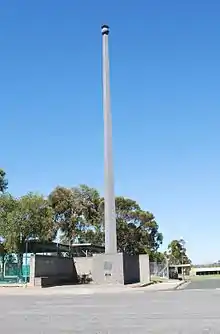
- In 1950 Menzies was awarded the Legion of Merit (Chief Commander) by US President Harry S. Truman for "exceptionally meritorious conduct in the performance of outstanding services 1941–1944 and December 1949 – July 1950".
- On 1 January 1951 he was appointed to the Order of the Companions of Honour (CH)[97]
- On 29 August 1952, the University of Sydney conferred the degree of Doctor of Laws (honoris causa) on Menzies.[98] Similarly, He was awarded an Honorary Doctor of Laws by the Universities of Bristol, Belfast, Melbourne, British Columbia, McGill, Montreal, Malta, Laval, Quebec, Tasmania, Cambridge, Harvard, Leeds, Adelaide, Queensland, Edinburgh, Birmingham, Drury and California.[99]
- In 1954, the portrait painting Rt. Hon. R. G. Menzies, PC, CH, QC, MP by Sir Ivor Hele won the Archibald Prize
- On 4 April 1960, a portrait of Menzies by Sir William Dargie was the front cover of Time magazine. This portrait is held by the Art Gallery of New South Wales
- In 1963, Menzies was appointed a Knight of the Order of the Thistle (KT),[100] the order being chosen in recognition of his Scottish heritage. He is the only Australian ever appointed to this order. He was the second of only two Australian prime ministers to be knighted during their term of office (the first prime minister, Edmund Barton, was knighted during his term in 1902).
- On 29 April 1964 Menzies was awarded the honorary degree of a Doctor of Letters (DLitt) by the University of Western Australia.[101] Menzies was also awarded with an Honorary Doctor of Science by the University of New South Wales.[99]
- In 1973 Menzies was awarded Japan's Order of the Rising Sun, Grand Cordon, First Class (other Australian prime ministers to be awarded this honour were Edmund Barton, John McEwen, Malcolm Fraser and Gough Whitlam).[102]
- On 7 June 1976, he was appointed a Knight of the Order of Australia (AK). The category of Knight of the order had been created only on 24 May, and the Chancellor and Principal Knight of the Order, the Governor-General Sir John Kerr, became the first appointee, ex officio. Menzies' was the first appointment made after this.
- In 1984, the Australian Electoral Commission proclaimed at a redistribution on 14 September 1984, the Division of Menzies for representation in the Australian House of Representatives in honour of the former prime minister. The division neighbours Menzies's old division of Kooyong in metropolitan Melbourne, Victoria.
- In 1994, the year of the centenary of Menzies's birth, the Menzies Research Centre was created as an independent public policy think tank associated with the Liberal Party.
- In 2009, during the Australia Day celebrations, the R.G. Menzies Walk was officially opened by the then Governor-General, Quentin Bryce. The walk runs alongside the northern shore of Lake Burley Griffin in Australia's capital, Canberra.[103]
- In 2012, a life-sized bronze statue of Menzies was erected on the R.G. Menzies Walk.[104]
- Sir Robert Menzies Park, in Wahroonga, New South Wales[105]
- Sir Robert Menzies Reserve, in Malvern, Victoria
- The high-rise Menzies building on the Clayton campus of Monash University
![]()
![]()
![]()
![]()
![]()
![]()
![]()
![]()
Decorations
 1950, he was appointed a Chief Commander of the Legion of Merit
1950, he was appointed a Chief Commander of the Legion of Merit 
 1951, he was appointed a Companion of the Order of the Companions of Honour (CH)
1951, he was appointed a Companion of the Order of the Companions of Honour (CH) 
 1963, he was appointed a Knight of the Order of the Thistle (KT)
1963, he was appointed a Knight of the Order of the Thistle (KT) 
 1973, he was appointed a Grand Cordon First Class of the Order of the Rising Sun
1973, he was appointed a Grand Cordon First Class of the Order of the Rising Sun 
 1976, he was appointed a Knight of the Order of Australia (AK)
1976, he was appointed a Knight of the Order of Australia (AK) .svg.png.webp)
Medals
 1935, he was awarded the King George V Silver Jubilee Medal
1935, he was awarded the King George V Silver Jubilee Medal 
 1937, he was awarded the King George VI Coronation Medal
1937, he was awarded the King George VI Coronation Medal 
 1953, he was awarded the Queen Elizabeth II Coronation Medal
1953, he was awarded the Queen Elizabeth II Coronation Medal 
Menzies ministries
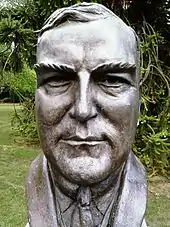
Actors who have played Menzies
- In the 1984 mini series The Last Bastion, Menzies was portrayed by John Wood.
- In the 1987 mini series Vietnam, he was portrayed by Noel Ferrier.
- In the 1988 mini series True Believers, he was portrayed by John Bonney.
- In the 1996 Egyptian film Nasser 56, he was portrayed by Egyptian actor Hassan Kami.
- In the 2007 film Curtin, he was portrayed by Bille Brown.
- In the 2008 television documentary Menzies and Churchill at War, he was portrayed by Matthew King.
- Max Gillies has caricatured Menzies on stage and in the comedy satire series The Gillies Report.
- In the 2015 documentary The Dalfram Dispute 1938, Menzies was portrayed by Bob Baines[108]
- In 2016 Menzies was portrayed by Alan Dearth in the A Place to Call Home episode "Home to Roost".
Eponyms of Menzies
- Sir Robert Menzies Memorial Foundation
- Menzies School of Health Research Australia
- R. G. Menzies Building, Australian National University Library
- Menzies Research Centre
- Menzies College (La Trobe University)
- Robert Menzies College (Macquarie University)
- Sir Robert Menzies Building (Monash University, Clayton Campus)
- The Australian federal electoral division of Menzies.[109]
- Menzies Wing (Wesley College, Melbourne)
- Menzies Research Institute
- Menzies Wing (St John's College, University of Sydney)
Notes and references
- Martin, Allan (1993), p. 5.
- Martin, Allan (1993), p. 4.
- Martin, Allan (1993), p. 1.
- Martin, Allan (1993), p. 2.
- Campbell Rhodes (19 June 2017). "Tosspot to Bodgie: Seven Prime Ministerial nicknames". Museum of Australian Democracy. Retrieved 2 June 2018.
- Cameron Hazlehurst (1979). Menzies Observed. Allen & Unwin. p. 14.
- Martin, Allan (1993), p. 7.
- Martin, Allan (2000). "Menzies, Sir Robert Gordon (Bob) (1894–1978)". Australian Dictionary of Biography. 15. Melbourne University Press. ISSN 1833-7538 – via National Centre of Biography, Australian National University.
- Martin, Allan (1993), p. 11.
- Martin, Allan (1993), p. 12.
- Martin, Allan (1993), p. 15.
- Martin, Allan (1993), p. 18.
- Martin, Allan (1993), p. 19.
- Caitlin Stone and Jim Berryman (2013). "The Robert Menzies Collection at the University of Melbourne" (PDF). University of Melbourne. Retrieved 2 June 2018.
- Martin, Allan (1993), p. 20.
- Martin, Allan (1993), p. 24.
- Percy Joske (1978). Sir Robert Menzies, 1894–1978: A New, Informal Memoir. Angus & Robertson. pp. 19–20.
- "Before office - Robert Menzies (26 April 1939 – 29 August 1941; 19 December 1949 – 26 January 1966) and Pattie Menzies". Archived from the original on 28 September 2013. Retrieved 26 September 2013.
- Martin, Allan (1993), p. 29.
- "Military Forces of the Commonwealth". Commonwealth of Australia Gazette (32). 24 April 1915. p. 739.
- Martin, Allan (1993), p. 275.
- Cathcart, Michael (1988). Defending the National Tuckshop. McPhee Gribble Publishers. ISBN 014011629X.
- Martin, Allan (1993), p. 30.
- Troy Bramston (2019), Robert Menzies: the art of politics, Melbourne, Scribe, p.35. ISBN 9781925713671
- "Australian Military Forces". Commonwealth of Australia Gazette (27). 24 March 1921. p. 470.
- Martin, Allan (1993), pp. 66–67.
- "Australia's PMs, Robert Menzies, Before Office". Archived from the original on 28 September 2013. Retrieved 26 September 2013.
- Peter Monteath, "The Kisch visit revisited." Journal of Australian Studies 16#34 (1992) pp: 69–81.
- David Bird (15 February 2014). Nazi Dreamtime: Australian Enthusiasts for Hitler's Germany. Anthem Press. p. 47. ISBN 978-1-78308-124-0.
- "Let's stop this distortion of Australian Jewish history". 30 November 2017.
- "Mr. Menzies' "Departed Friends"". The Mirror. 17 (891). Western Australia. 15 July 1939. p. 17. Retrieved 10 December 2019 – via National Library of Australia.
- Christopher Waters, "Understanding and Misunderstanding Nazi Germany: Four Australian visitors to Germany in 1938," Australian Historical Studies (2010) 41#3 pp: 369–384
- Andrews, E. M. (1967). "The Australian Government and Appeasement". Australian Journal of Politics & History. 13 (1): 34–46. doi:10.1111/j.1467-8497.1967.tb00310.x.
- "Nazism in Australia has a long history. Here's the short version". 16 January 2019.
- Sparrow, Jeff (22 July 2015). "If you oppose Reclaim Australia, remember fascism wasn't always a freakshow | Jeff Sparrow". The Guardian. Retrieved 10 December 2019.
- Robert Menzies, Declaration of War, broadcast 3 September 1939
- Menzies, Robert (1939). Declaration of War.
- "AM Archive - Letter revealed Menzies' view of Hitler". www.abc.net.au. Retrieved 10 December 2019.
- Mallory, Greg (1999). "The 1938 Dalfram Pig-iron Dispute and Wharfies Leader, Ted Roach". The Hummer. 3 (2).
- Martin, Allan (1993), p. 285.
- David Day, Menzies and Churchill at War (1993) pp 9–26
- Paul Hasluck, The Government and the People: 1939–1941 (1951)
- Australian Broadcasting Corporation documentary "Menzies and Churchill at War" (2008) by Film Australia.
- "In office – Robert Menzies – Australia's PMs". Primeministers.naa.gov.au. Archived from the original on 13 November 2013. Retrieved 17 October 2012.
- "John Curtin: before office". National Archives of Australia. Archived from the original on 13 July 2017. Retrieved 19 July 2017.
- "Before office – Arthur Fadden – Australia's PMs – Australia's Prime Ministers". Primeministers.naa.gov.au. Archived from the original on 19 August 2012. Retrieved 17 October 2012.
- Scott Brodie (1984). Australia's Prime Ministers. NSW, Australia: PR Books. ISBN 0-86777-006-6.
- "Ministries and Cabinets". parliamentary Handbook. Parliament of Australia. Archived from the original on 8 October 2012. Retrieved 17 September 2010.
- "After office – William Morris Hughes – Australia's PMs". Primeministers.naa.gov.au. Archived from the original on 26 June 2012. Retrieved 17 October 2012.
- "The Forgotten People – Speech by Robert Menzies (22 May 1942)". Liberals.net. 22 May 1942. Retrieved 4 November 2011.
- Menzies, Robert; Kemp, David (2011). The Forgotten People and Other Studies in Democracy. Melbourne: The Liberal Party of Australia (Victorian Division). p. 12. ISBN 9780646555171.
- "Royal Commission – The Petrov Affair".
- "Josh Frydenberg, 2014 Sir Robert Menzies Lecture". Archived from the original on 6 April 2017.
- "Josh Frydenberg 2014 Sir Robert Menzies Lecture". Archived from the original on 6 April 2017.
- Starr, Graeme (2001). "Menzies and Post-War Prosperity". Liberalism and the Australian Federation Edited by John Nethercote.
- https://www.theaustralian.com.au/commentary/opinion/hit-the-very-wealthy-with-more-tax-as-robert-menzies-did/news-story/8953321ef14d6074db39803d3a722776%5B%5D
- "Indigenous Vote".
- Nethercote, John (2001). Liberalism and the Australian Federation. Sydney: Federation Press. p. 191. ISBN 978-1862874022.
- "Australia's Prime Ministers, Robert Menzies, Timeline". Archived from the original on 3 March 2016. Retrieved 10 February 2016.
- Howard, John (2014). The Menzies Era: The Years that Shaped Modern Australia. Sydney: HarperCollins Publishers. pp. 320–321. ISBN 9780732296124.
- Howard. Menzies Era. p. 351.
- "Fact Sheet – Abolition of the "White Australia" Policy". Archived from the original on 1 September 2006.
- "Fact Sheet – Abolition of the "White Australia" Policy". Archived from the original on 13 December 2017.
- "What Menzies really thought of the Commonwealth".
- Quiggin, John (3 February 2019). "The deplorable word (updated)". John Quiggin. Retrieved 25 May 2020.
- Henderson, Gerard (26 April 2011). "The way we were: quiet, maybe, but certainly not dull". The Sydney Morning Herald.
- Howard. The Menzies Era. p. 246.
- Howard. Menzies Era. p. 350.
- Frame, Tom (2005). The Life and Death of Harold Holt. Allen & Unwin / National Archives of Australia. p. 137. ISBN 978-1-74114-672-1.
- Alan Ramsey, "Your humble servant, Sir", Sydney Morning Herald, 2 October 1999, p. 47
- Australian Academy of Science (2018). "Sir Robert Gordon Menzies". Retrieved 24 January 2018.
- "MENZIES Robert Gordon". Legal Opinions. Australian Government Solicitor. Archived from the original on 8 May 2014. Retrieved 7 May 2014.
- "Former Office-Bearers". University Secretary's Department University Calendar. The University of Melbourne. Archived from the original on 28 March 2014. Retrieved 7 May 2014.
- http://menziesvirtualmuseum.org.au/the-1970s/menzies-reflects-australia-matures%7C%5B%5D Menzies Research Center – Retrieved 7 February 2016
- "Menzies, Robert Ian - Biographical entry - The Robert Menzies Collection: A Living Library". Menziescollection.esrc.unimelb.edu.au. Retrieved 21 February 2017.
- "Henderson, Margery Heather - Biographical entry - The Robert Menzies Collection: A Living Library". Menziescollection.esrc.unimelb.edu.au. Retrieved 21 February 2017.
- "Argus (Melbourne, VIC) - Australian Newspapers". MyHeritage. Retrieved 21 February 2017.
- "Menzies, Kenneth Leckie - Biographical entry - The Robert Menzies Collection: A Living Library". Menziescollection.esrc.unimelb.edu.au. Retrieved 21 February 2017.
- Entertainment (9 March 2014). "Daughter's insights cast new light on Robert Menzies". The Sydney Morning Herald. Retrieved 21 February 2017.
- Mungo MacCallum (6 July 2002). "Sex, power and politics". The Age. Retrieved 17 June 2018.
- "Menzies, Fairfax and that affair: Mungo MacCallum replies". Crikey. 3 November 2006. Retrieved 17 June 2018.
- "Rumours of Menzies's philandering greatly exaggerated". Crikey. 6 November 2006. Retrieved 17 June 2018.
- https://www.menziesrc.org/sir-robert-menzies/history-of-sir-robert-menzies Archived 6 February 2016 at the Wayback Machine | Menzies Research Centre – Retrieved 6 February 2016
- "Prince here tomorrow – Rush trip to Menzies funeral". The Age. Melbourne. 17 May 1978. p. 1. Retrieved 12 August 2010.
- http://primeministers.naa.gov.au/primeministers/menzies/after-office.aspx Archived 3 March 2016 at the Wayback Machine | NAA – Former Prime Ministers, Menzies after office – Retrieved 6 February 2016
- Powerhouse Museum. "Poster, 'Pig Iron Bob dead at last'". Powerhouse Museum, Australia. Retrieved 22 September 2016. The poster is part of the Di Holloway collection at the Sydney Powerhouse Museum
- Martin, Allan (1993), pp. 22–23.
- Howard. Menzies Era. p. 325.
- "Julia 2010: The caretaker election".
- 26, corporateName=Australian Electoral Commission; address=50 Marcus Clarke Street, Canberra ACT 2600; contact=13 23. "House of Representatives - Two party preferred results 1949 - present".CS1 maint: numeric names: authors list (link)
- Governor-General of Australia
- Stuart Macintyre. A Concise History of Australia.
- 3600, corporateName=National Archives of Australia; address=Queen Victoria Terrace, Parkes, ACT 2600; contact=+61 2 6212. "In office - Robert Menzies (26 April 1939 – 29 August 1941; 19 December 1949 – 26 January 1966) and Pattie Menzies". Archived from the original on 13 November 2013.CS1 maint: numeric names: authors list (link)
- Henry "Jo" Gullett (1992), Good company; Horseman, soldier, politician, Brisbane, University of Queensland Press, pp.226-7. ISBN 0-7022-2443-X
- "Inkstand presented to Sir Robert Menzies in Commemoration of the Commonwealth Royal Tour 1954, National Museum of Australia". Nma.gov.au. Retrieved 4 November 2011.
- The Robert Menzies Collection: A Living Library; retrieved 18 October 2013.
- "It's an Honour: CH". Australian Government. Archived from the original on 4 June 2011. Retrieved 15 October 2009.
- "The Right Honourable Robert Gordon Menzies". University of Sydney. Archived from the original on 18 August 2010. Retrieved 15 October 2009.
- "University Secretary's Department – Former Office-Bearers". University of Melbourne. Archived from the original on 3 March 2016. Retrieved 15 October 2009.
- "No. 42964". The London Gazette. 9 April 1963. p. 3155.
- "Speech by Sir Robert Menzies in Winthrop Hall, University of Western Australia". University of Western Australia. Retrieved 15 October 2009.
- Honour awarded 1973 – National Archives of Australia Archived 20 May 2009 at the Wayback Machine
- "R. G. Menzies Walk 'National Capital'". Archived from the original on 13 March 2016. Retrieved 8 March 2016.
- http://www.canberratimes.com.au/act-news/permanent-place-for-menzies-in-nations-heart-20120323-1vpob.html | Permanent Place for Menzies in nations heart, Canberra Times – Retrieved 20160308
- Ku-Ring Gai Council - Retrieved 20161214
- https://www.walesonline.co.uk/news/wales-news/people-who-freedom-swansea-what-15831860
- "Freedom of city for Sir Robert". The Age. 9 April 1966. p. 3.
- "The Dalfram Dispute 1938 : Pig Iron Bob DVD". Why Documentaries. Retrieved 11 May 2018.
- Origins of Current Divisions Name – Current Divisions, Australian Electoral Commission web site
Further reading
- Brett, Judith (1992) Robert Menzies's Forgotten People, Macmillan, (a sharply critical psychological study)
- Cook, Ian (1999), Liberalism in Australia, Oxford University Press, South Melbourne, Victoria, Ch. 7 'Robert Menzies'. ISBN 0-19-553702-5
- Day, David. (1993) Menzies and Churchill at War (Oxford University Press)
- Hazlehurst, Cameron (1979), Menzies Observed, George Allen and Unwin, Sydney, New South Wales. ISBN 0-86861-320-7
- Henderson, Anne. (2014) Menzies at War
- Hughes, Colin A (1976), Mr Prime Minister. Australian Prime Ministers 1901–1972, (Melbourne: Oxford University Press) Chs. 13 and 18. ISBN 0-19-550471-2
- Martin, Allan (1993). Robert Menzies: A Life - 1894–1943. Vol. 1. Melbourne University Press. ISBN 0522844421.
- Martin, Allan (1999). Robert Menzies: A Life - 1944-1978. Vol. 2Martin. Melbourne University Press. ISBN 9780522848649.
- — (May 1996). "Mr Menzies's anticommunism". History. Quadrant. 40 (5): 47–56.
- Martin, Allan (2000), 'Sir Robert Gordon Menzies,' in Grattan, Michelle, "Australian Prime Ministers", New Holland Publishers, pages 174–205. (very good summary of his life and career) ISBN 1-86436-756-3
- Nethercote, J.R., ed. (2016). Menzies: The Shaping of Modern Australia. Connor Court. ISBN 9781925501018.
- Starr, Graeme (1980), The Liberal Party of Australia. A Documentary History, Drummond/Heinemann, Richmond, Victoria. ISBN 0-85859-223-1
External links
| Wikimedia Commons has media related to Robert Menzies. |
| Wikiquote has quotations related to: Robert Menzies |
| Library resources about Robert Menzies |
- Papers of Robert Menzies, 1905–1978, National Library of Australia, approximately 82.30 m. (588 boxes) + 99 fol. boxes.
- "Robert Menzies". Australia's Prime Ministers. National Archives of Australia. Archived from the original on 24 July 2018. Retrieved 29 June 2010.
- "Robert Menzies". National Museum of Australia. Retrieved 29 June 2010.
- The Menzies Foundation
- The Menzies Virtual Museum
- The Menzies Centre for Australian Studies, London
- The Liberal Party's Robert Menzies website
- Listen to Menzies's declaration of war on australianscreen online
- Menzies's declaration of war was added to the National Film and Sound Archive's Sounds of Australia registry in 2010
- The Robert Menzies Collection: A Living Library
- Robert Menzies Notebook Collection, The University of Melbourne
- Charcoal Sketch – Menzies Collection
- Newspaper clippings about Robert Menzies in the 20th Century Press Archives of the ZBW
